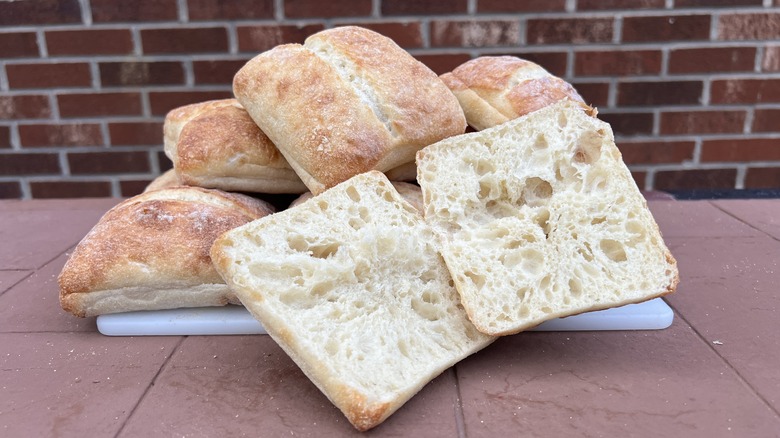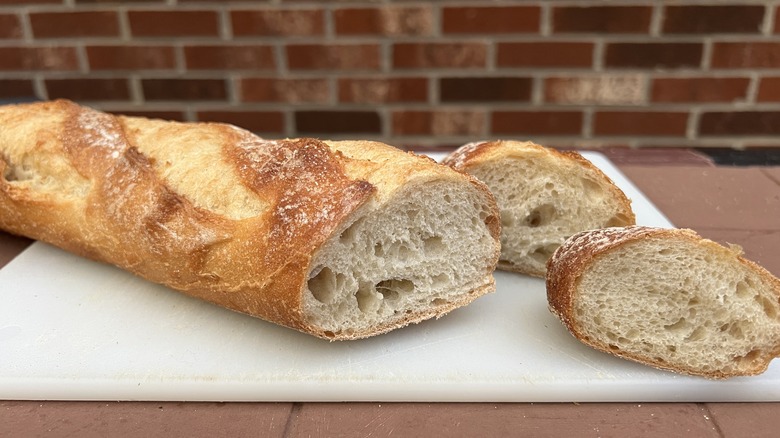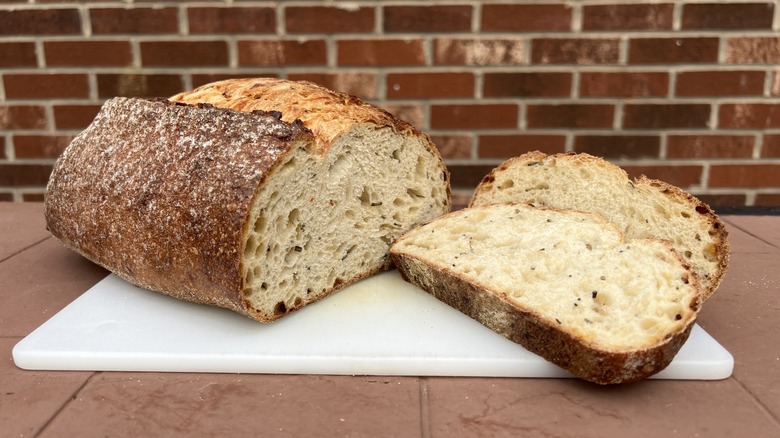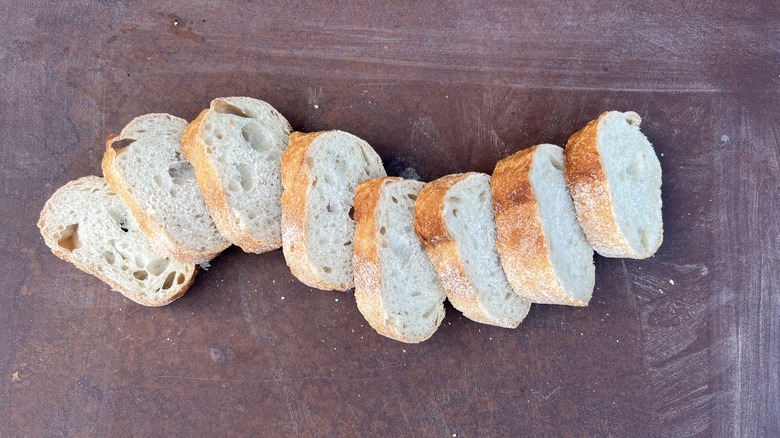7 Breads From Costco's Bakery, Ranked Worst To Best
Costco's bakery turns out an impressive amount of bread on a daily basis. Not every location carries the same products, but items like croissants, rolls, bagels, and baguettes are very common. So are bread loaves, which come in varieties ranging from a simple sourdough to a complex rosemary and Parmesan cheese loaf. A few of these breads live up to their artisanal titles, while others leave something to be desired. To save you the trouble of putting each product to the test, I, with a little help from my family, rounded up several products from Costco's bakery and ranked them from worst to best based on factors like flavor and texture.
I tested each of these products plain, since it's common for bread to taste better after you toast it or add a condiment. I also sampled items on the day they were purchased to ensure that they were at peak quality. This is because some breads, particularly the ones with more crust, tend to go stale quickly. Because Costco sells everything in such large quantities, you might want to consider freezing some of these items if you don't expect to finish them within a few days. Of course, you could also have all your friends over for a delicious brunch — just don't forget to invite me!
7. Everything bagels
What makes New York the bagel capital of the world is also what makes Costco's bagels lackluster and unsatisfying. All else could be forgiven if the texture was just right. Granted, there aren't many mass-produced bagels that come close to what you might buy from a bagel shop, so I can't be too hard on Costco. The everything bagels, which come in packages of six, taste, feel, and look like the bagels you might find at many other grocery stores: conservative in flavor, a little dry, lacking in crust, and too flat.
Upon the first bite, I knew immediately that I wanted a bolder flavor from these bagels. Not only could the bagel itself be tangier, but in an age where everyone is obsessed with everything bagel seasoning, Costco shouldn't hesitate to bring its A-game and use a heavier hand when dosing out spices like sesame, poppy seeds, onion, and garlic. I also yearned for a glossier crust with more chew, a characteristic that can only be obtained if bagel manufacturers have fine-tuned the water bath given to bagels before baking. Finally, I wanted a thicker bagel, which would require better calibration of the ingredients and improved shaping.
Given the number of aspects in which Costco's everything bagels fell short, I felt like I was eating round-shaped bread — not a bagel. The best way to rescue them, of course, was to load them up with toppings like cream cheese, tomatoes, sprouts, hummus, and avocado.
6. Multigrain loaf
The multigrain loaf is one of the select items that the Costco bakery actually makes from scratch. In this case, however, I did not feel that the loaf's freshness was indicative of a superior flavor or texture. This was somewhat of a disappointment, given that it had an enticing aroma and I generally enjoy multigrain bread. As it stands, Costco's multigrain loaf does not distinguish itself much from any other generic loaf of multigrain bread. I thought the crust was too hard and chewy, and I craved a higher quantity of oats and seeds. This would have given the loaf additional flavor and a more complex texture. As it stands, the recipe features a meager amount of flax, sesame, and sunflower seeds. In short, I felt that this bread mimics the flavor and texture of white bread too extensively, and that it therefore does not fully do justice to the dark, rich, seedy potential of a first-rate multigrain bread.
Alas, I was left with a sizable loaf and had to figure out some use for it. My family and I made its flavor more complex by dipping it in balsamic vinegar. Pairing it with a robust cheese, like a sharp cheddar, provolone, or gouda, would also help take this bread to another level.
5. Artisan rolls
Costco's artisan rolls are inspired by ciabatta, an Italian style of white bread that is known for its open crumb structure, satisfyingly crunchy crust, and somewhat sweet flavor. "Ciabatta" may be difficult to pronounce for most Americans (it's "chuh-baat-tuh"), but don't be discouraged by the fancy name; ciabatta-style rolls are sturdy enough to complement classic comfort dishes like sloppy Joes and tomato sandwiches.
Ciabatta is a relatively new style of bread, but many bakers and manufacturers have nevertheless been able to perfect their recipes in the time since. Sadly, I think Costco still has a ways to go. These rolls are sold in 12-packs and have a pleasant amount of chew and a fair amount of sponginess. They spring back to their original shape after each bite. This was the lightest bread I sampled and the best bread for sandwiches, especially considering the rolls come partially sliced.
However, the texture of the rolls felt slightly gummy, an observation shared by other Costco customers on social media. One user on a Reddit thread, who identified themselves as a Costco employee working in the bakery, confirmed that they had "noticed the quality drop off over the last few months." Don't necessarily blame the employees at your local Costco for the deterioration in quality, however. This employee shared that these rolls are among the products that arrive at the store frozen. Grilling, broiling, or toasting the rolls can help rescue their texture, and you might not notice it at all if you are using them to serve a dish with a lot of moisture, such as a gravy sandwich or soup.
4. Baguettes
I've been thinking about baguettes ever since the Paris Olympics and "Emily in Paris" aired. Costco's baguettes come in packs of two, which is just the right amount if you are having a medium-sized get together and are serving bruschetta or a charcuterie board. Baguettes and olive oil can also be an easy, elegant starter to a fancy dinner; after all, we all know crusty bread is the absolute best for dipping in oil. The baguette's famously long and narrow dimensions allow the crust to absorb just the right amount of olive oil.
The interior of Costco's baguette was very soft, and when paired with a crisp crust, the bread was satisfyingly chewy. Keep in mind that you should generally skip the toasting step for baguettes unless you enjoy feeling like you are biting into a rock. Since they're neutral in taste, Costco's baguettes would be wonderful when topped with pesto, Brie, or butter and jam. That said, I would have appreciated a slightly sweeter flavor.
Because baguettes should ideally be enjoyed within one day of baking, I used the leftover baguette to make French toast the next morning. And if you want to really take inspiration from the French, you can dip day-old baguette into your morning cup of joe. Regardless, I was happy to see that the baguettes did not turn stale immediately, which meant my family and I could enjoy them for several days after we purchased them.
3. Butter croissants
In another ode to Parisian cuisine, Costco's butter croissants, which are sold in packages of 12, do reasonable justice to everyone's favorite flaky pastry. From experience, I knew that these croissants are best when they're toasted; applying heat takes their texture from soft and spongy to crisp and flaky. Nobody likes a dry croissant, and I was pleasantly surprised by how moist and buttery these croissants were. Even so, I thought that they could have used a smidge less butter; the oiliness of these pastries was reminiscent of the buttery biscuits served by many fast food chains. The butter does not weigh down the croissants, though, as they retain an acceptable amount of fluffiness.
It can be puzzling to figure out how to eat a croissant without making a huge mess. While some croissants fall apart the moment you look at them, Costco's have great structural integrity and are therefore the perfect vehicle for hearty sandwich fillings. I used croissants to make tomato and basil sandwiches for lunch one day and the next morning, I smeared the croissants with banana butter. After putting Costco's croissants to the test in both sweet and savory recipes, I can safely say that they are well-suited to both.
2. Rosemary Parmesan cheese loaf
My second favorite bread was also the most strikingly flavorful. While the rosemary and Parmesan were not overpowering, the presence of each ingredient was unmistakable. One might expect to find the Parmesan baked into the crust, similar to Panera Bread's asiago cheese bagels. Instead, it is incorporated into the dough so that its flavor remains consistent in each bite, where it perfectly complements the loaf's multigrain flavor. The crust was chewy, but not tough — it had just the right amount of bite — and the interior was soft as a pillow.
I ate this bread plain alongside tomato soup, and its sponginess was well-suited to sopping up every last drop. I thought this bread would also be an easy swap for savory French toast, especially when ingredients like oregano, thyme, butter-infused olive oil, and broiled cherry tomatoes are used instead of the traditional array of sweet ingredients. This loaf retained its freshness well enough to enjoy pimento cheese and tomato sandwiches on it for several days after purchase.
1. Rustic Italian loaf
Sometimes the simple things in life are the most enjoyable, and this adage holds true when it comes to Costco's rustic Italian loaf. Its flavor is unobtrusive — one might say subtly complex — and its thin crust was tastier than the crust of any other bread on this list. It had a light crunchiness that contrasted beautifully with the bread's soft, moist interior. This bread also had a noticeable aftertaste that I thoroughly enjoyed; it had a mild and delicate sweetness.
The rustic Italian loaf's flavor was so pleasant that my family and I were happy to eat this bread on its own, without any toppings. Even so, I thought it would be a good candidate for a generous smear of butter, a sun-dried tomato and olive tapenade, or a dipping dish full of high-quality olive oil. It would also pair exquisitely with a bowl of pasta.
Methodology
At the time of writing this article, my local Costco only had seven bread options available for purchase. I, along with my family members, tasted each bread on its own before pairing it with other dishes or ingredients that may prove complementary (such as soup and balsamic vinegar). Each of us reviewed the products based on their flavor and texture. The rankings submitted by each family member were nearly identical, which limits the influence of personal preference in this review.
I reviewed products by focusing purely on flavor and texture. Prices for each item were similar and therefore not considered.








